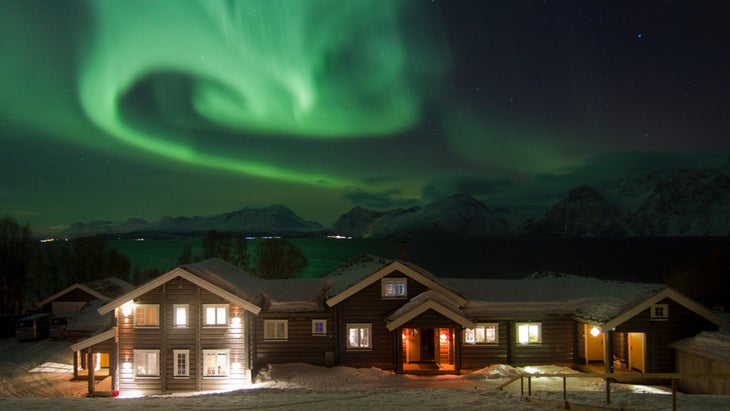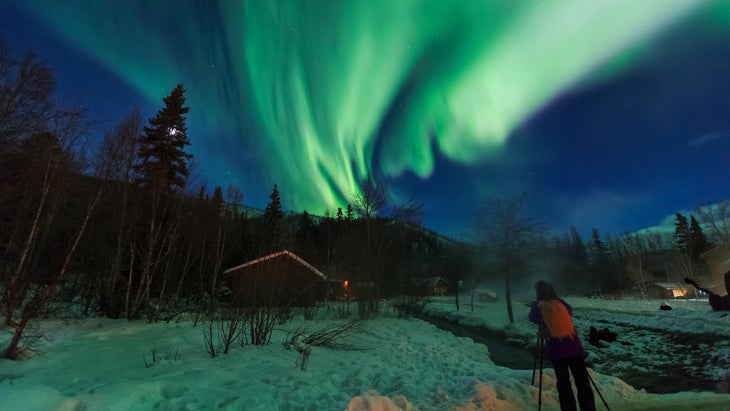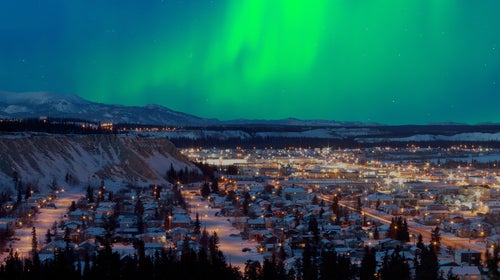Catching the northern lights, or aurora borealis, used to be a chance occasion, a rare fluke for those lucky enough to be in the right place at the right time. But nowadays, scientists have figured out more accurate ways to predict when and where the northern lights will appear.
“Scientists around the world are still working to understand the aurora,” says Dr. Kathryn McWilliams, director of the SuperDARN Canada National Research Facility and a professor of physics and engineering physics at Canada’s University of Saskatchewan. “There are many types of instruments, on the ground and in space, that monitor auroral conditions, and there are many scientific and government websites with maps of the auroral oval, which is the region with the highest probability of seeing the aurora.”
The University of Alaska Fairbanks has an aurora forecast that estimates conditions weeks ahead of time. You can also check out the Space Weather Prediction Center, where scientists from the National Oceanic and Atmospheric Administration monitor and track the likelihood of the aurora happening. And, of course, there’s an app: My Aurora Forecast shows a map of the best locations in the world for viewing the lights now or weeks from now.
Generally speaking, the best time of year to see the northern lights is from late August to mid-April, because those are the darkest months of the year, but you can certainly catch the aurora in midsummer if you time it right. The best sightings will occur during the darkest hours of the night, between 10 P.M. and 2 A.M.
Picking a geographic location close to the North Pole will help boost your chances of seeing the northern lights—northern-latitude places like Iceland, Canada, Alaska, Norway, Finland, and Sweden are often sure bets. But you’ll also need to make sure you’re far from any light pollution and have a clear night sky without clouds, storms, or a too-bright full moon. We’ve picked some of our favorite spots in the Northern Hemisphere for catching the lights.
Where to Go to Watch the Northern Lights

1. Voyageurs National Park, Minnesota
This 218,000-acre national park is one of the most remote northern spots in the lower 48. The International Dark-Sky Association designated it an official dark sky park in 2020, meaning there’s minimal light pollution way out here. Pitch a tent at one of the park’s more isolated campgrounds—there are 15 hike-in or boat-in backcountry campsites—for the best viewing spots in the park. If you’d rather have a bed to sleep in, stay at the 31-room Cantilever Hotel (from $169) in the town of Ranier, ten minutes from the park’s entrance, which has a rooftop sauna and hot tub for night sky-gazing, free yoga, and whiskey tasting at the in-house distillery.

2. Djupvik, Norway
Backcountry skiers visit Norway’s Lyngen Alps in winter for the legendary ski touring. While there, they might be treated to a brilliant showing of the northern lights. Stay at the eight-room boutique Lyngen Lodge (from $234) and you’ll have guided backcountry skiing by day and northern lights photography classes by night. To get here, you’ll fly into Tromsø, a popular northern lights destination, then drive 2.5 hours into the Lyngen Alps, where the lodge sits on the edge of a fjord.

3. Fairbanks, Alaska
From August to April, you can see the northern lights in Fairbanks on most clear nights. The city even has its own aurora tracker for the latest status from six prime viewing locations around the area. Sign up for an aurora tour if you want a guided perspective: Northern Alaska Tour Company offers tours by ground or air. Sleep in a geodesic igloo with a clear roof or a tiny cube with floor-to-ceiling windows at Borealis Basecamp, 25 miles outside of Fairbanks, where two-night packages (from $980) include dogsledding and snowmobiling.
4. Whitehorse, Canada
Twenty minutes outside the Yukon city of Whitehorse, Northern Lights Resort recently added three new glass chalets, with prime nighttime viewing of the northern lights and three-night packages (from $1,190). Or catch the lights from a hot tub: the new Eclipse Nordic Hot Springs in Whitehorse is slated to open this year with four outdoor soaking pools. Want even more of an adventure? Fly into Old Crow, the northernmost community in the Yukon, and take a tour with Josie’s Old Crow Adventures, an Indigenous-led guided operation that leads night tours and dogsled excursions.
5. Levi, Finland
If Santa Claus lives anywhere, it might be Levi, a charming village fit for elves 100 miles north of the Arctic Circle in the heart of Finnish Lapland. In winter, Levi is home to one of the biggest ski resorts in Finland, but many people also come here for the northern lights. Sleep in one of 24 glass-roofed igloos at Levin Iglut (from $274), where even the on-site restaurant has entirely glass walls and ceiling.
6. Hella, Iceland
Here’s a hotel amenity we can get behind: at the 51-room Hotel Rangá (from $428) in southern Iceland, if you select the aurora wake-up service, the hotel will buzz your in-room phone whenever the lights appear at night, ensuring you won’t miss the spectacle. Once you’re awake, you can watch the night sky from three geothermally heated hot tubs or the hotel’s own rooftop observatory. This hotel is located between the towns of Hella and Hvolsvöllur, about an hour’s drive into the countryside from Iceland’s capital city of Reykjavík.
